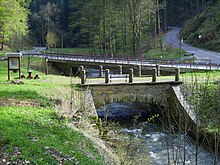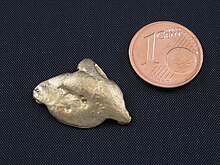Cat (Schwarza)
The cat is the most water-rich tributary of the upper Schwarza in the Thuringian Slate Mountains . Most of the mountain range between Katzhütte , Scheibe-Alsbach and Neuhaus am Rennweg , the Wurzelberg massif, is drained by it.
Origin and course
The river Katzen is created by the union of the Großer Wulstbach and Hölle at the lower Wulst (former forester's house). On its way to the mouth of the Schwarza in the center of Katzhütte, it takes in some small streams: from the left Frauenbach and Reichenbach, from the right Apelsbach and Bärentiegel. There are also other small rivulets and springs that do not flow constantly or that only carry little water all year round.
Naming
The name of the river cat goes back to the Wendish "Kaza" and means: wild, raging, devastating. In 1566 a Saigerhütte was built in Rosenthal, at the confluence of the Katzen in the Schwarza . The hut on the cat was later named after the village of Katzhütte.
bridges
Since the approximately 5 km long course of the river winds several times from one side of the valley to the other, numerous bridges cross the river bed.
Road bridges
1. Bridge a few meters in front of the mouth of the cat in the Schwarza; Bahnhofstrasse runs over this bridge. Neuhäuser Straße leads over all other bridges.
2. Bridge behind the "mill"; It was rebuilt in 1997.
3rd bridge at the "Schützenhof"; New building in 1998
4. Bridge behind the town exit, popularly known as the “Third Bridge”. It is the third bridge on Neuhäuser Strasse. A new road bridge was built there in 1994 to cope with the growing traffic. The old stone arch bridge is under monument protection and was restored in the same period according to old pictures.
5. Bridge at the mouth of the Apelsbach in the Katzen, popularly known as the “Fourth Bridge”.
6. bridge on the lower bead; It was built in the mid-1950s and has only been accessible from one side since 2013 due to its dilapidation.
Forest bridges
Bridge to the Frauenbachtal; It serves the forestry development of the forests on the mountain slopes of the Frauenbachtal.
Bridges to residential properties
Due to the narrowness of the Katzetal, residential development is only possible on one side in some parts of Neuhäuser Straße. That is why every owner of a residential property in the section between the school and Grünertsgasse has built a bridge over the cat as the only access to the property. There are 17 bridges on a road length of 290 m, which in most cases can also be crossed by car.
Economic use in earlier times
Cutting mills
The hydropower of the cat and its tributaries was used for centuries to drive mill wheels. The abundance of wood in the catchment area of this river led to the construction of a total of 9 cutting mills.
- Upper bead cutting mill below Neuhaus am Rennweg
- Lower bead cutting mill at the confluence of the Großer Bulstbach and Hölle rivers
- Cutting mill at the pot break at Apelsbach
- Frauenbachschneidemühle at the confluence of the Frauenbach in the Katzen
- Cutting mill in Frauenbachtal (cutting mill crucible)
- Cutting mill on the upper Frauenbach
- Bear crucible mill on the cat
- Reichenbach cutting mill
- Voigt'sche Mühle in the district of Mühle an der Katzen. This was initially a grinding mill and was later converted into a cutting mill
Log rafting
The forestry use of the forests of Wurzelberg and Lindig began as early as the 13th century. Since there were no fixed roads and paths back then, the rivers were used to transport logs down the valley. Rafting was only possible when the rivers were in high water. In addition, raft ponds were created at the tributaries to the cat, the dams of which could be opened if necessary in order to use this water reserve to extend the flood period. These included Wulstteich, Schellertsteich, Höllenteich, Mittelbacher Teich, Jungfrau, Altfrau and Reichenbach ponds as well as 2 Apelsbach ponds. In 1873 the log rafting came to an end.
particularities
- A pensioner from Katzhütte was particularly lucky when, on April 4, 2004, while crossing the cat at a ford, he found a 9.64 g heavy nugget made of real gold. As a result, a gold washing area was set up at the site. Gold panning events are organized several times a year so that hobby gold panners can try their luck. Outside of these dates, panning for gold in cats is prohibited for nature conservation reasons.
- The cat tunnel was built between 1989 and 1994 so that water from the cat can be channeled into the Leibis-Lichte dam if necessary . The weir system and inlet structure are located below the Bärentiegel, about 1 km from the Katzhütte exit towards Neuhaus am Rennweg.
Web links
Individual evidence
- ↑ Heinz Deubler: The upper reaches of the Schwarza and the Wurzelberg, In: Rudolstädter Heimathefte, Rudolstadt 1981, issue 1/2 p. 12
- ^ Berthold Sigismund: Landeskunde des Fürstenthums Schwarzburg-Rudolstadt, Part II, Ortskunde der Oberherrschaft, Rudolstadt 1863, p. 176
- ^ Eduard Kühne: Chronicle of Katzhütte, Gehren 1891, Arnstadt 2012, p. 4
- ↑ Tobias Rosenbaum and Heinz Martin: The mills along the bead and the cat, In: Neuhäuser Heimathefte, Neuhaus am Rennweg 2009, issue 3, p. 4



